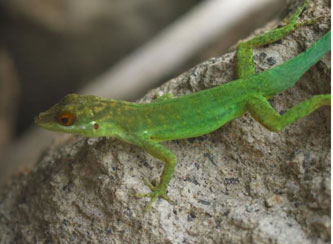Animals on islands more abundant than mainland
Animals on islands more abundant than mainland
By Kim McDonal of the University of California, San Diego
April 30, 2007
A comprehensive survey of lizards on islands around the world has confirmed what island biologists and seafaring explorers have long observed: Animals on islands are much more abundant than their counterparts on the mainland.
Besides confirming that longstanding observation, the study signals an alarm for island populations in a rapidly warming world. It suggests that climate change may have devastating consequences for lizards and other animals that inhabit islands because their ecosystems are much more sensitive than those on the mainland to change.
Details of the study conducted by biologists at the University of California, San Diego will appear in a paper slated for publication in the June issue of the journal Ecology Letters, available online in May.
 Anolis lividus, on the Caribbean island of Montserrat. Credit: Lauren Buckley |
“We found that island populations are less resistant to biological invasions, which will likely increase dramatically with changing climate,” says Walter Jetz, an assistant professor of biological sciences at UCSD and a co-author of the study.
“Climate change will drive animals to move to new places,” says Lauren Buckley, a postdoctoral fellow at the Santa Fe Institute who is a visiting scholar at UCSD and the other co-author of the study. “Our research suggests that those animals that move to islands can strongly affect the sensitive animal communities on islands.”
In addition to their increased sensitivity to biological invasions, populations on islands are more vulnerable than those on the mainland to sea level rise and increased storm activity, which are expected by many scientists to become worse as a result of global warming.
Jetz and Buckley gathered 643 estimates of lizard abundance from around the world for their survey, the first extensive global study of island densities for any animal group. Analyzing these estimates, they determined that lizards were consistently more than ten times more abundant on islands than on the mainland.
Previous research conducted by Ted Case at UCSD and others on small groups of islands had found that islands’ limited areas and isolation can reduce predation and competition pressures. As a result, island animals were able to reach exceptionally high densities.
In their study, Jetz and Buckley confirmed that reduced numbers of predators and competitors accompany high lizard densities on islands across the world. The two biologists concluded that an average acre of mainland contains 52 lizards while an island acre contains 777 lizards. This difference in density persisted when the scientists controlled for location and environmental conditions.
“The ecology of islands is particularly important because, while the world’s more than 100,000 islands constitute only 7 percent of the global land surface, they contain many of the earth’s species with numerous species restricted to single islands,” says Buckley. “500 million people depend on island ecosystems for their food and livelihoods.”
The study suggests that islands are particularly sensitive to the loss and gain of species. Species introductions have had dramatic consequences for islands. Introduced mongooses have devastated island populations of lizards and introduced snakes have caused the loss of birds and lizards on islands.
“Cases of species introductions wreaking havoc on islands are likely to become more common as the islands face increasing pressures from population growth, tourism, development, and climate change,” says Jetz. “The consequences of island vulnerability have already been observed as island species account for half of known animal extinctions and a full 90 percent of known bird extinctions in the last 400 years. Our study suggests that islands will continue to be vulnerable worldwide.”
“Many people, myself included, enjoy visiting islands for their spectacular wildlife,” adds Buckley. “Our research suggests that we must be particularly careful to limit the movement of animals between islands if islands are to remain special places to visit.”
Related articles
World’s only pure blue lizard at risk of extinction. High above the forest floor on the remote Colombian island of Gorgona lives a lizard with brilliant blue skin, rivaling the color of the sky. Anolis gorgonae, or the blue anole, is a species so elusive and rare, that scientists have been unable to give even an estimate of its population. Due to the lizard’s isolated habitat and reclusive habits, researchers know little about the blue anole, but are captivated by its stunning coloration.
Female lizards may determine male coloration. Male lizard color may result from female preference. The anole lizard’s dewlap — a flap of skin that hangs beneath its chin — plays an important role in species recognition, territorial defense and courtship. According to the Smithsonian Tropical Research Institute (STRI), a leading research institution in Panama, male slender anoles (Norops limifrons) exhibit variation in dewlap color ranging from orange dewlaps in Gamboa populations, white with an orange spot on Barro Colorado Island, and mixed populations in Soberania.
This is a modified news release from the University of California at San Diego